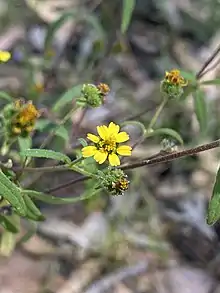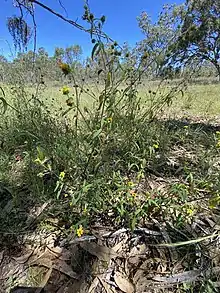Sigesbeckia orientalis
Sigesbeckia orientalis, commonly known as Indian weed[2] or common St. Paul's wort,[3] is a species of flowering plant in the family Asteraceae. It is a small, upright, sparsely branched shrub with yellow flowers. There is debate whether it is a native plant in Australia, Linnaeus referred to it as a "small ugly weed".
| Sigesbeckia orientalis | |
|---|---|
 | |
| Scientific classification | |
| Kingdom: | Plantae |
| Clade: | Tracheophytes |
| Clade: | Angiosperms |
| Clade: | Eudicots |
| Clade: | Asterids |
| Order: | Asterales |
| Family: | Asteraceae |
| Genus: | Sigesbeckia |
| Species: | S. orientalis |
| Binomial name | |
| Sigesbeckia orientalis | |

Description
Sigesbeckia orientalis is an annual, upright herb or subshrub, about 0.4–1.5 m (1 ft 4 in–4 ft 11 in) high, usually multi-branched with reddish coloured, hollow stems. The leaves may be triangular-shaped, lance-shaped to broadly lance-shaped, and up to 2–17 cm (0.79–6.69 in) long, 1–7 cm (0.39–2.76 in) wide, petiole up to 2 cm (0.79 in) long, underside has small, yellow glands. The upper and lower surface of the leaf blade is sparsely hairy, the margin has pointed to rounded teeth, larger teeth nearer the base, gradually narrowing, base wedge-shaped, and rough on both surfaces. The yellow or orange flowers are borne in clusters of about 15 sessile flowers per head, about 10 mm (0.39 in) in diameter, usually containing female and hermaphrodite flowers. There are about 8 ray florets, each ligule 1–2 mm (0.039–0.079 in) long, and 10-15 disc florets. The fruit is a dark brown to black cypsela, 2–3 mm (0.079–0.118 in) long, curved and ridged. Flowering and fruiting occurs all months of the year.[2][4][5]
Distribution
Sigesbeckia orientalis has a broad distribution in Africa, Asia, but has been widely naturalised outside this range.[6] It is unclear whether it is native to Australia or has been introduced there.[7]
Nomenclature
Academician Johann Siegesbeck who disagreed with Linnaeus' sexual system of classification based on plants' reproductive organs, described his work as "loathsome harlotry". Linnaeus named the small, ugly weed Sigesbeckia orientalis after Johann Siegesbeck for revenge.[8]
References
- "Sigesbeckia orientalis". Australian Plant Census. Retrieved 29 January 2021.
- Murray, L. "Sigesbeckia orientalis". PlantNET-NSW Flora online. Royal Botanic Garden Sydney. Retrieved 29 January 2021.
- "Sigesbeckia orientalis". Natural Resources Conservation Service PLANTS Database. USDA. Retrieved 14 November 2015.
- Walsh, Neville. "Sigesbeckia orientalis". VICFLORA-Flora of Victoria. Royal Botanic Gardens Victoria. Retrieved 29 January 2021.
- Wilson (ed), Annette (2015). Flora of Australia Vol 37 Asteraceae 1. Canberra: CSIRO. p. 583. ISBN 9781486304165.CS1 maint: extra text: authors list (link)
- "Sigesbeckia orientalis". Germplasm Resources Information Network (GRIN). Agricultural Research Service (ARS), United States Department of Agriculture (USDA). Retrieved November 16, 2013.
- "Sigesbeckia orientalis L." New South Wales Flora Online. Royal Botanic Garden, Sydney. Retrieved November 16, 2013.
- Lynn Barber. The Heyday of Natural History. New York: Doubleday, 1980. p. 54. See also Strange Science, biography of Linnaeus
External links
 Media related to Sigesbeckia orientalis at Wikimedia Commons
Media related to Sigesbeckia orientalis at Wikimedia Commons Data related to Sigesbeckia orientalis at Wikispecies
Data related to Sigesbeckia orientalis at Wikispecies